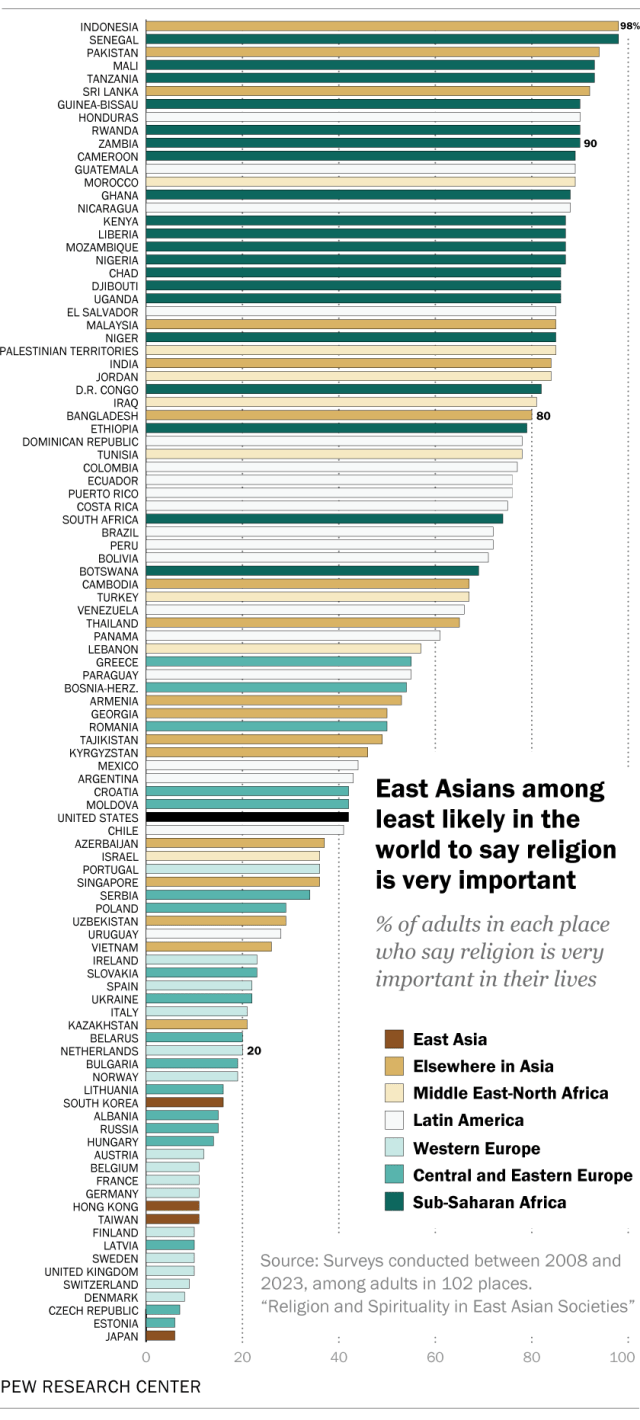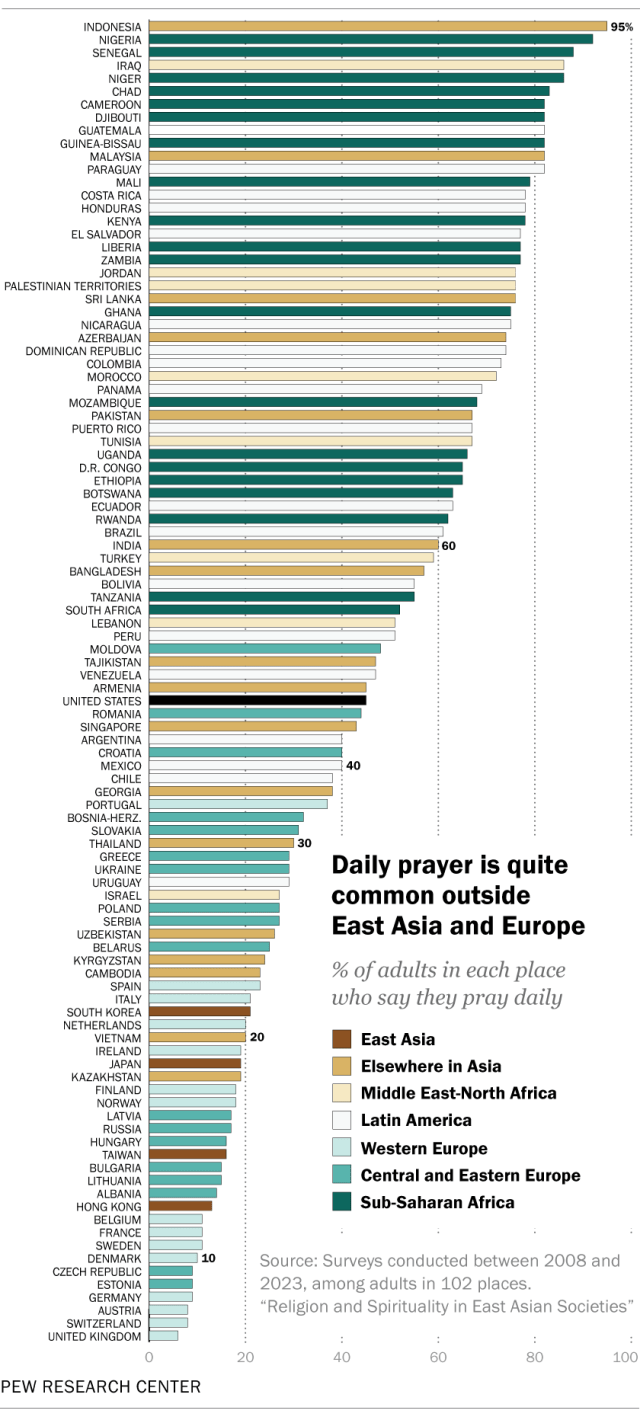World
Where is the most religious place in the world?

Over the last decade and a half, Pew Research Center has conducted religion-focused surveys all around the world. One question we have asked in each of these surveys is “How important is religion in your life?” Another one we’ve asked repeatedly is “How often do you pray?”
Using these questions, we see a broadly similar pattern across the 102 countries and territories we surveyed between 2008 and 2023. The places that are most religious by these two measures tend to be in sub-Saharan Africa, Latin America and the Middle East-North Africa region. The places that are least religious tend to be in Europe and East Asia.
Of course, there are dimensions of spirituality that these two survey questions don’t pick up, as we’ve explored in regional surveys. At the end of this analysis, we discuss how we could incorporate new measures in the future.
Pew Research Center conducted this analysis to look back at the religion-focused survey research we’ve done around the world for the last decade and a half. The analysis also describes some of our future plans for measuring spirituality and religiosity around the world.
This analysis is primarily based on our recent report, Religion and Spirituality in East Asian Societies. For that report, we surveyed 10,390 adults across East Asia and neighboring Vietnam. Local interviewers administered the survey in seven languages from June to September 2023.
Interviews were conducted over the phone in four places: Hong Kong, Japan, South Korea and Taiwan. In Vietnam, interviews took place face-to-face.
Respondents were selected using a probability-based sample design. Data was weighted to account for different probabilities of selection and to align with demographic benchmarks for the adult population.
For more information, refer to the report’s Methodology and the full survey questionnaire.
This survey is part of the Pew-Templeton Global Religious Futures project, which analyzes religious change and its impact on societies around the world.
Data for the nearly 100 other countries and territories in this analysis comes from previous religion-focused surveys conducted between 2008 and 2023: sub-Saharan Africa; the Middle East-North Africa region and many countries with large Muslim populations; Latin America; Israel; Central and Eastern Europe; Western Europe; India; South and Southeast Asia; and the United States. Additional information on these previous surveys can be found in the report’s appendix.
Importance of religion around the world
People in sub-Saharan Africa are typically among the most likely to say that religion is very important in their lives. At least 90% of adults say this in Senegal, Mali, Tanzania, Guinea-Bissau, Rwanda and Zambia.

In contrast, people in nearly all European countries surveyed are among the least likely to say that religion is very important in their lives. In Estonia, the Czech Republic, Denmark, Switzerland, the United Kingdom, Sweden, Latvia and Finland, 10% or fewer adults say this.
The pattern in South and Southeast Asia is not as consistent as in sub-Saharan Africa and Europe. Adults in some places in this region are among the most likely worldwide to place a great deal of importance on religion. Consider Indonesia, for example, where nearly all adults say religion is very important in their lives. But far smaller shares in Singapore (36%) and Vietnam (26%) give this answer.
In the United States, 42% of adults say religion is very important in their lives. This is below the 102-place median of 55%.
Rates of daily prayer around the world

Latin Americans are among the most likely in the world to say they pray daily. In both Guatemala and Paraguay, 82% of adults say this, as do 78% in Costa Rica and Honduras.
Meanwhile, in no place surveyed in East Asia do more than 21% of adults say they pray daily. This includes 13% of people in Hong Kong and 19% in Japan.
Adults in the U.S. are in the middle of the 102 countries and territories analyzed when it comes to rates of daily prayer. Some 45% of Americans say they pray daily, which is nearly identical to the 102-place median of 46%.
The complexities of measuring religiosity globally
Asking people about the importance of religion in their lives and how often they pray can provide an important window into their religiosity. But these questions work better in some places than in others.
These two measures may be especially valuable in places where Abrahamic religions – Judaism, Christianity and Islam – predominate, because prayer and formal religious organizations are central to those traditions. In other parts of the world, we need to ask additional questions to capture key aspects of religious or spiritual observance.
A prime example is our 2023 survey of East Asian societies and neighboring Vietnam. Before this survey, we consulted with experts from the region to devise questions that would tap into the most relevant aspects of spirituality. We also conducted qualitative research in Japan and Taiwan to ensure we were taking the right approach.
The survey found that while few East Asians consider religion very important in their lives or pray daily, many people across the region hold religious or spiritual beliefs and engage in traditional rituals. For example, many East Asians participate in rituals to honor their ancestors.
We also asked tailored, culturally relevant questions in our 2019-20 survey of nearly 30,000 adults in India. For example, that survey found widespread adherence to dietary choices related to religion. We found that 92% of Jains are vegetarian, and 67% of India’s Jains also abstain from eating root vegetables. Among all Indian adults, only about half said they would ever eat in the home of someone whose religion has different rules about food.
How we plan to measure religiosity and spirituality around the world in the future
Our recent survey of East Asia and Vietnam largely marks the end of our customized, region-by-region surveys of religiosity and spirituality. But this does not mean we are done researching religion around the world.
Building on what we’ve learned, we now plan to conduct surveys in 30 or more countries at the same time. By simultaneously surveying countries in Asia, Africa, Europe and the Americas, we can gain a comparative understanding of spirituality around the world.
As we survey the same countries over time, we can also repeat some questions to see how different parts of the world are – or aren’t – changing religiously.
This new approach will allow us to ask questions around the world that were originally designed for a specific region. For example, based on our work in East Asia, we plan to ask respondents across the globe whether they think various parts of nature have their own spirits. We recently asked questions like these in the U.S. and found that 48% of American adults believe that mountains, rivers or trees can have spirits or spiritual energies. This is similar to the share of adults in Japan and Vietnam who believe in such spirits.
Using measures from a variety of cultures and religious traditions will help us move toward a richer understanding of people’s spiritual lives.



/cdn.vox-cdn.com/uploads/chorus_asset/file/24435784/tokyostrava.jpg)





